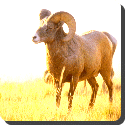 Bighorn — Bighorn Sheep (Ovis canadensis) is one of three species of mountain sheep in North America and Siberia; the other two species being Ovis dalli, that includes Dall Sheep and Stone’s Sheep, and the Siberian Snow sheep Ovis nivicola.
Bighorn — Bighorn Sheep (Ovis canadensis) is one of three species of mountain sheep in North America and Siberia; the other two species being Ovis dalli, that includes Dall Sheep and Stone’s Sheep, and the Siberian Snow sheep Ovis nivicola.
Bighorn Sheep are named for the large, curved horns borne by the males, or rams. Females, or ewes, also have horns, but they are short with only a slight curvature. They range in color from light brown to grayish or dark, chocolate brown, with a white rump and lining on the back of all four legs. Rocky Mountains bighorn females weigh up to 200 pounds (90 kg), and males occasionally exceed 300 pounds (135 kg). In contrast, Sierra Nevada bighorn females weigh about 140 pounds (63 kg) with males weighing around 200 pounds (90 kg). Males’ horns can weigh up to 30 lb (14 kg), as much as the rest of the bones in the male’s body.
Bighorn sheep graze on grasses and browse shrubs, particularly in fall and winter, and seek minerals at natural salt licks. Bighorns are well adapted to climbing steep terrain where they seek cover from predators such as coyotes, eagles, and cougars. They live in large herds, but do not have the strict dominance hierarchy of the mouflon: that is, they do not automatically follow a single leader ram, unlike the Asiatic ancestors of the domestic sheep.
 Kids Portal For Parents India Kids Network
Kids Portal For Parents India Kids Network






